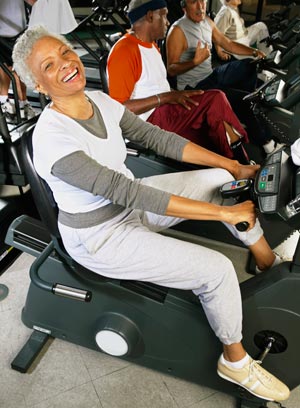·
Don't consider stretching a warm-up. You may hurt yourself if you stretch cold
muscles. So before stretching, warm up with light walking, jogging or biking at
low intensity for five to 10 minutes. Or better yet, stretch after you exercise
when your muscles are warmed up. Also, consider holding off on stretching
before an intense activity, such as sprinting or track and field activities.
Some research suggests that pre-event stretching before these types of events
may actually decrease performance.
·
Focus on major muscle groups. When you're stretching, focus on your calves, thighs, hips,
lower back, neck and shoulders. Also stretch muscles and joints that you
routinely use at work or play. And make sure that you stretch both sides. For
instance, if you stretch your left hamstring, be sure to stretch your right
hamstring, too.
·
Don't bounce. Bouncing as you stretch can cause small tears in the muscle.
These tears leave scar tissue as the muscle heals, which tightens the muscle
even further, making you less flexible and more prone to pain. So, hold each
stretch for about 30 seconds. Repeat each stretch three or four times.
·
Don't aim for pain. Expect to feel tension while you're stretching, not pain. If it
hurts, you've pushed too far. Back off to the point where you don't feel any
pain, then hold the stretch.
·
Make stretches sport specific. Some evidence suggests that it's helpful to do stretches
tailored for your sport or activity. If you play soccer, for instance, you're
more vulnerable to hamstring strains. So opt for stretches that help your
hamstrings.
·
Keep up with your stretching. Stretching can be time-consuming. But you can achieve the best
benefits by stretching regularly, at least two to three times a week. If you
don't stretch regularly, you risk losing any benefits that stretching offered.
For instance, if stretching helped you increase your range of motion, and you
stop stretching, your range of motion may decrease again.
·
Bring movement into your stretching. Gentle movement can help you be more flexible
in specific movements..
Talk to your doctor or physical therapist about the best way to
stretch if you have any health concerns. Otherwise, I can
show you how to perform stretches correctly.
 There's no doubt that childhood obesity has become a nationwide issue, the future implications of which largely remain unknown. According to a new
There's no doubt that childhood obesity has become a nationwide issue, the future implications of which largely remain unknown. According to a new 
 If you’ve ever thought you aren’t standing as straight and tall as you once did, find walking up a flight of stairs to be a strain at times, or you groan when reaching for the arms of a chair as you slowly get up from sitting, you aren’t alone.
If you’ve ever thought you aren’t standing as straight and tall as you once did, find walking up a flight of stairs to be a strain at times, or you groan when reaching for the arms of a chair as you slowly get up from sitting, you aren’t alone.